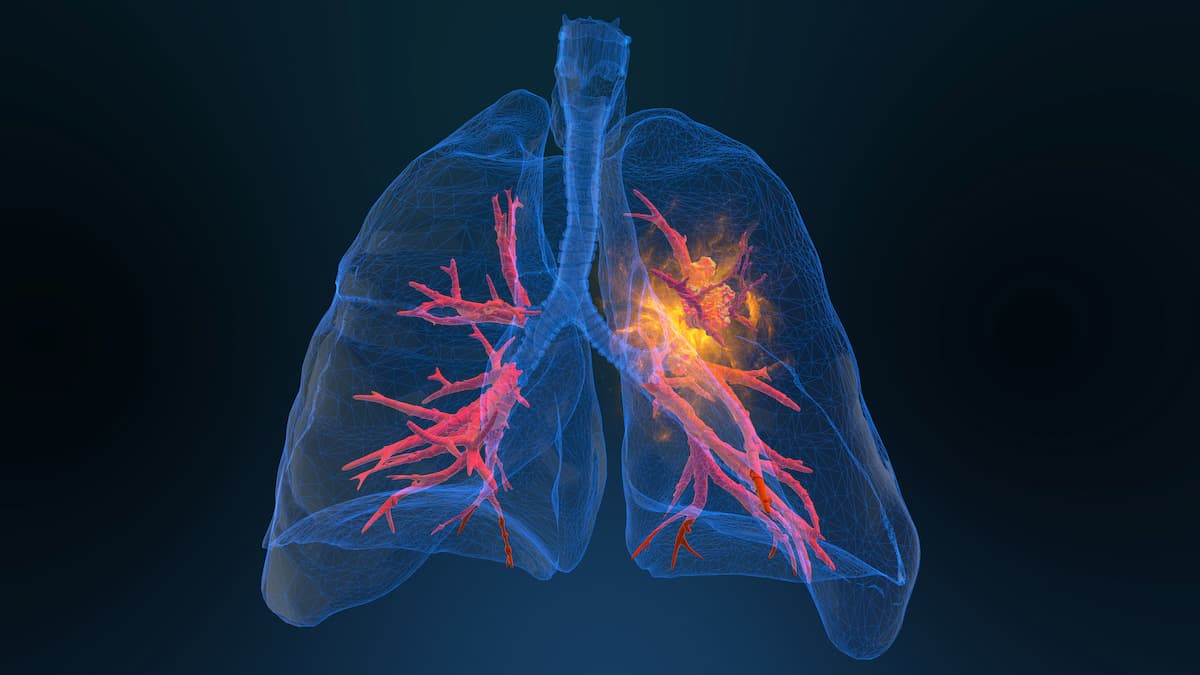Chemoimmunotherapy-Enhanced Survival vs Chemotherapy Alone in ES-SCLC
Patients with ES-SCLC who received immunotherapy plus chemotherapy experienced a median OS of 14.9 months vs 11.9 months with chemotherapy alone.
A real-world study found chemotherapy with immunotherapy improved efficacy outcomes vs chemotherapy alone in extensive-stage SCLC.

Chemotherapy in combination with immunotherapy led to prolonged survival outcomes without increasing the frequency of treatment-related adverse events (TRAEs) vs chemotherapy alone in patients with extensive-stage small cell lung cancer (ES-SCLC), according to a real-world study published in Scientific Reports.1
In the combination therapy group, the median overall survival (OS) was 14.9 months (range, 3.4-67.3) vs 11.9 months (range, 3.1-63.6) with chemotherapy alone (P < .001); after propensity score matching to minimize selection bias, the advantage with combination therapy remained statistically significant. With chemotherapy plus immunotherapy, the 1-, 2-, and 3-year OS rates, respectively, were 62.4%, 42.8%, and 19.5% with chemotherapy plus immunotherapy vs 50.2%, 20.8%, and 9.6% with chemotherapy alone (P = .0054). The multivariate Cox proportional hazards model showed an HR of 1.00 for the chemotherapy plus immunotherapy group vs 1.193 (95% CI, 0.956-1.490; P = .119) with chemotherapy alone; thus, the survival difference was not statistically significant.
In a multivariate analysis for OS, the number of metastatic sites and ECOG performance status were independent prognostic factors associated with poorer outcomes.
The median PFS was 5.4 months (range, 1.6-43.6) with combination therapy vs 3.8 months (range, 1.1-32.6) with chemotherapy alone; the 1-year PFS rates were 18.6% and 4.3%, respectively (P < .0001). The multivariate Cox proportional hazards model showed an HR of 1.466 (95% CI, 1.179-1.822; P < .001); thus, PFS was statistically improved in patients with the combination therapy.
In a multivariate analysis for PFS, treatment with chemotherapy alone, the number of metastatic sites, and ECOG performance status were independent risk factors associated with disease progression.
In the combination group, the objective response rate (ORR) was 69.4%, with 2.3% of patients achieving a complete remission (CR), 67.1% achieving partial remission (PR), 24.9% having stable disease (SD), and 5.8% having disease progression (PD). In the chemotherapy alone group, the ORR was 56.8%; additionally, 1.1% of patients achieved CR, 55.7% achieved PR, 22.7% had SD, and 20.5% had PD. This difference in efficacy between the groups was statistically significant (P = .000).
“Patients with ES-SCLC generally have poor prognoses after clinical treatment, and treatment outcomes often fail to meet expectations,” said corresponding study author Ying-Nan Zhou, of the Department of Radiotherapy and Chemotherapy at Cangzhou Hospital of Integrated Traditional Chinese and Western Medicine East Ward in Hebei, China, in the study. “This study demonstrates that chemotherapy combined with immunotherapy can significantly prolong OS and PFS in patients with ES-SCLC without substantially increasing TRAEs.”
This retrospective study included data from 349 patients with ES-SCLC who were treated at Cangzhou Hospital of Integrated Traditional Chinese and Western Medicine from January 2018 to August 2023; of the patients, 173 received chemotherapy plus immunotherapy and 176 received chemotherapy alone.
Eligible patients had histologically or cytologically confirmed SCLC; were restaged to the 2-stage system of the Veterans Administration Lung Study Group and the 8th edition of the American Joint Committee on Cancer TNM staging system, confirming the diagnosis of ES-SCLC; received standard first-line chemotherapy with platinum-based drugs combined with etoposide, with or without immunotherapy; and had complete medical records available.
Those with a secondary primary tumor, autoimmune diseases, severe dysfunction of vital organs, and receipt of high-dose systemic corticosteroids or other immunosuppressive agents within 4 weeks of the study were excluded from participation.
Treatment in the combination group consisted of one of the following immunotherapy regimens: etoposide plus carboplatin (EC) or cisplatin (EP) plus 4.5 mg/kg of intravenous serplulimab (Hetronifly; n = 84), EC/EP plus 1200 mg of intravenous atezolizumab (Tecentriq; n = 52), EC plus 1500 mg of intravenous durvalumab (Imfinzi; n = 19), or EP plus 1500 mg of intravenous durvalumab (n = 18).
In the chemotherapy alone group, patients in the EC group received intravenous etoposide at 100 mg/m2 on days 1 to 3, with carboplatin at area under the curve 5 to 6 on day 1, every 3 weeks for 4 to 6 cycles (n = 82); in the EP group, patients received etoposide at 80 to 100 mg/m2 on days 1 to 3 and cisplatin at 25 to 80 mg/m2 on day 1 every 3 weeks for 4 to 6 cycles (n = 94).
Treatment follow-up was conducted through medical record reviews, regular telephone calls, and outpatient visits; they occurred every 2 months during year 1, every 3 to 4 months during years 2 and 3, every 6 months during years 4 and 5, and annually every year after.
The trial’s primary end points were OS and PFS; the secondary end point was TRAEs graded via Common Terminology Criteria for Adverse Events v5.0.
A subgroup analysis compared survival outcomes between those who received EC vs EP. The median OS was 13.8 months in the EP group and 12.5 months in the EC group (log-rank P = .27); the median PFS was 6.2 months vs 5.6 months (log-rank P = .19). These results were not statistically significant.
TRAEs were experienced by 83.8% of the combination group, 45.1% of which were chemotherapy-related AEs and 38.7% of which were immunotherapy-related AEs, compared with 79.0% of the chemotherapy group. Grade 1/2 TRAEs occurred in 59.5% of the combination group and 60.2% of the chemotherapy group; grade 3/4 TRAEs occurred in 24.3% and 18.2%, respectively. No grade 5 TRAEs were observed in either group. No significant difference in the incidence of TRAEs between both groups was found (χ² = 1.347; P = .246).
“Further research is needed to explore resistance mechanisms and biomarkers to optimize treatment strategies and improve patient outcomes,” the authors concluded.
Reference
Zhou JX, Sun YC, Xiao L, et al. Efficacy analysis and prognostic factors of first-line chemotherapy combined with immunotherapy in extensive-stage small cell lung cancer: a real-world study. Sci Rep. 2025;15(1):13063. doi:10.1038/s41598-025-98018-8